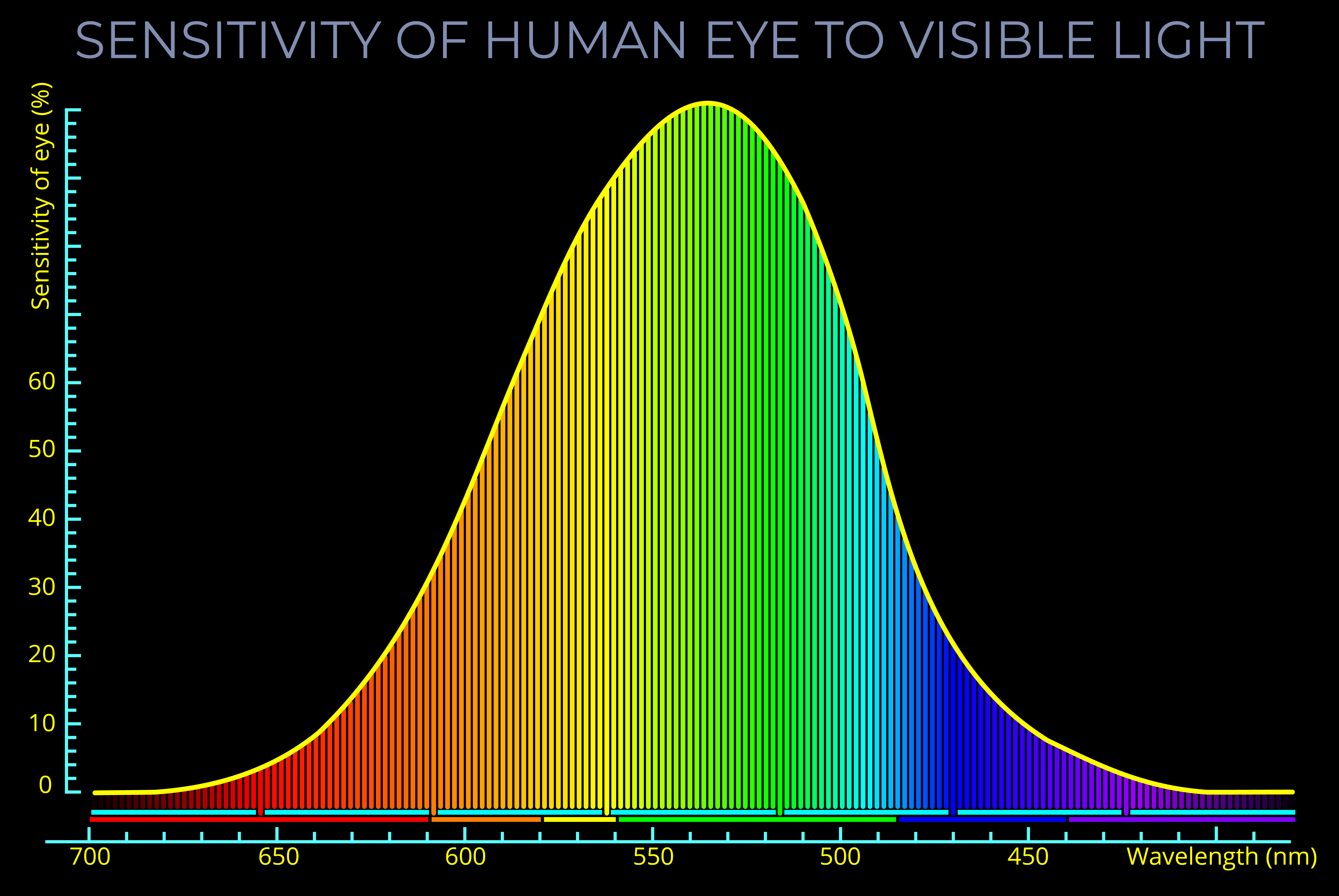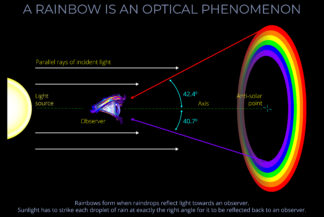Sensitivity of Human Eye to Visible Light
£0.00
This diagram is a new addition to the site! More information will be added ASAP 🙂
Description
Sensitivity of Human Eye to Visible Light
TRY SOME QUICK QUESTIONS AND ANSWERS TO GET STARTED
About the diagram
- In this context the term ‘sensitivity of the eye’ refers to the varying response of the rods and cones in the human eye to different wavelengths of light.
- The diagram illustrates the varying response of the eye to wavelengths between approximately 380 and 700 nanometres (nm). These are the wavelengths of the visible colour spectrum.
- The information is in the form of a graph. The vertical axis shows the variation in sensitivity in degrees on a scale between zero and 100%.
- The horizontal axis arranges the scale of wavelengths to reflect the commonly used sequence of ROYGBV. In this arrangement red (700 nm) is at the origin of the two axes on the left and violet (380 nanometres) is on the right.
- The diagram splits the spectrum into 150 different wavelengths from red to violet but there are 198 colours in total from infrared to ultraviolet which are both shown as black.
- Breaks in the cyan line along the bottom of the curve identify the position of ROYGBV. Below the cyan line is another line of colours which shows the range of wavelengths associated with each each spectral colour.
- To find out more about the way that the range of colours used in this diagram have been selected see (add link).
Some key terms
Interneurons are a type of neuron found in the nervous system of animals, including humans, which play a role in processing and communicating information.
- Interneurons can be classified into different types based on their functions, such as local circuit interneurons and relay interneurons.
- Local circuit interneurons have short axons and form circuits with nearby neurons to analyse and process information locally.
- Relay interneurons have long axons and connect circuits of neurons in different regions of the central nervous system, enabling communication and integration of information.
- Interneurons can be further classified into sub-classes based on their neurotransmitter type, morphology, and connectivity.
- Interneurons serve as nodes within neural circuits, enabling communication and integration of sensory and motor information between the peripheral nervous system and the central nervous system.
A virtual photon is a theoretical concept in particle physics. Virtual photons are thought to be particles that exist for an incredibly brief time and cannot be directly observed. Their existence is inferred through their role in mediating interactions between other particles.
- Virtual photons are created when two charged particles interact with each other. For example, when two electrons interact with each other, they can exchange a virtual photon. This exchange of a virtual photon causes the electrons to repel each other. The electric force that we observe is thought to be due to the exchange of virtual photons between charged particles.
- Virtual photons are thought to play a role in many different physical phenomena, including the electromagnetic force, the weak force, and the strong force.
- More generally, a photon is a particle that carries electromagnetic radiation. It is the fundamental unit of light.
A photon is a particle that carries electromagnetic radiation. It is the fundamental unit of light.
- Thinking of photons as particles is useful for understanding the quantum nature of light.
- In the world of quantum physics, photons are the fundamental constituents of all forms of electromagnetic radiation, including light. They serve as the carriers of the electromagnetic force.
- Photons are elementary particles that have no mass and no electric charge. They are the quanta of the electromagnetic field, which is the fundamental field that describes electromagnetic interactions. Electromagnetic radiation, including light, is a manifestation of the electromagnetic field.
- Photons are the carriers of electromagnetic force because they are the only particles that can mediate electromagnetic interactions. When two charged particles interact electromagnetically, they exchange photons. The exchange of photons gives rise to the electromagnetic force.<
- Photons have no rest mass and always travel at the speed of light in a vacuum.
- Photons exhibit both wave-like and particle-like properties, a characteristic referred to as wave-particle duality. This duality is inherent to quantum particles, causing light to behave as a wave under certain conditions, as both waves and photons in others, and strictly as particles in yet others.
- The observer effect is a principle of physics and states that any interaction between a particle and a measuring device will inevitably change the state of the particle. This is because the act of measurement itself imposes a disturbance on the particle’s wave function, which is the mathematical description of its state.
- The concept of observation refers to the act of engaging with an electron or other particle, achieved through measuring its position or momentum.
- In the context of quantum mechanics, observation isn’t a passive undertaking, observation actively alters a particle’s state.
- This means that any kind of interaction with an atom, or with one of its constituent particles, that provides insight into its state results in a change to that state. The act of observation is always intrusive and will always change the state of the object being observed.
- It can be challenging to reconcile this with our daily experience, where we believe we can observe things without inducing any change in them.
A human observer is a person who engages in observation by watching things.
- In the presence of visible light, an observer perceives colour because the retina at the back of the human eye is sensitive to wavelengths of light that fall within the visible part of the electromagnetic spectrum.
- The visual experience of colour is associated with words such as red, blue, yellow, etc.
- The retina’s response to visible light can be described in terms of wavelength, frequency and brightness.
- Other properties of the world around us must be inferred from light patterns.
- An observation can take many forms such as:
- Watching an ocean sunset or the sky at night.
- Studying a baby’s face.
- Exploring something that can’t be seen by collecting data from an instrument or machine.
- Experimenting in a laboratory setting.
Colour is not a property of electromagnetic radiation, but a feature of visual perception by an observer.
- The human eye and so human visual perception are tuned to the visible spectrum and so to spectral colours between red and violet.
- There are no properties of electromagnetic radiation that distinguish visible light from other parts of the electromagnetic spectrum.
- Objects appear to be different colours to an observer depending on the wavelengths, frequencies and amplitude of visible light at the moment it strikes the retina at the back of the eye.
Visual perception is the human ability to see and understand our surroundings by virtue of the sensitivity of our eyes to wavelengths of light across the entire visible spectrum, from red to violet.
- Visual perception is a complex process that relies on the intricate interaction between our eyes, the brain, and the interpretation of light signals. It enables us to perceive various visual attributes such as shapes, sizes, textures, depths, motions, and spatial relationships, all of which contribute to our comprehensive understanding and interpretation of the visual world around us.
Vision, the human visual system, is a complex interplay between various components of the eye, including the cornea, pupil, lens, iris, retina, and optic nerve. It collaborates to capture, focus, and convert light into electrical signals that are transmitted to the brain for visual processing and interpretation.
- Vision begins when light emitted or reflected by an object or scene enters our eyes through the cornea, pupil, and lens.
- The cornea and the lens work together to concentrate and focus light onto the retina, which is the photosensitive layer of cells at the back of the eyeball.
- The iris, located between the cornea and the lens, regulates the amount of light reaching the retina. It also determines eye colour and controls the size of the pupil.
- The retina plays a vital role in converting differences in the wavelength and brightness of incoming light into electrical signals.
- The optic nerve, which exits at the back of the eye, carries these signals to the visual processing areas of the brain.



